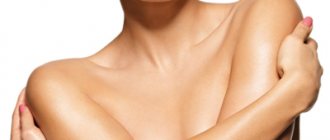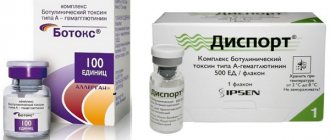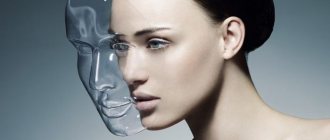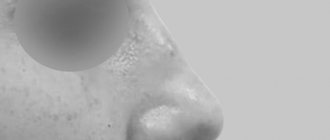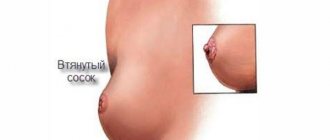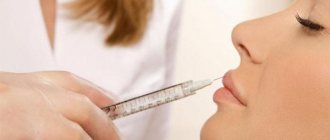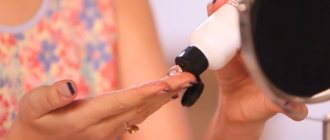Autologous fat grafting and fat-derived stem cell transplantation are two completely different aesthetic procedures with different levels of risk to the patient. Therefore, the issue of indications, contraindications and permits for specific clinics should be approached differently.
Autotransplantation of adipose tissue in plastic surgery has been used for quite a long time. But the same procedure in combination with adipose stem cells (stromal vascular fraction) has been known for a little over 15 years.
Concept and essence
Cheek lipofilling is the correction of facial contours by transplanting an autograft (a certain volume of the patient’s own fat reserves), which, after undergoing a special treatment that improves its properties, is introduced into the area of the cheeks, cheekbones and other segments of the face.
On the face, microlipografting is performed in different areas, which allows you to visually remove age-related changes and make you look ten years younger.
As practice shows, people with beautiful “high” cheekbones, both natural and obtained as a result of plastic surgery, are faced with the problem of sunken cheeks (dips under the cheekbones), which makes the face hard, gaunt, and also creates a “skeletalization” effect, which significantly increases age. Thanks to lipofilling of the cheekbones, you can simulate noble high cheekbones and at the same time create a soft roundness in the cheek area, which is characteristic of a young age.
Fat is introduced:
• in the temporal region - subfascially;
• in the frontal region - supraperiosteal;
• in the suborbital and supraorbital - only supraperiosteal;
• when filling the retraction of the upper eyelid - only axillary, under the orbicularis oculi muscle. In no case under the levator of the upper eyelid, nor under the skin, because there is only one operation with such a complication as subcutaneous contouring of the ridges - they are cut out. As a rule, the fat there turns into a cartilage-like conglomerate and is no longer absorbed by anything: neither corticosteroids nor enzymes.
Advantages
Lipofilling of the cheekbones and cheeks has certain advantages when comparing this procedure with other corrective and rejuvenating techniques.
The main advantages of this technique:
- The risk of rejection is reduced and allergic reactions are eliminated by using your own adipose tissue rather than artificial materials as filler.
- Not only skin tightening is observed, but also volumetric modeling of subcutaneous tissues.
- The result lasts for a long time, since the transplanted and adapted lipocytes (adipose tissue cells) remain forever in the treatment area. In addition, unlike artificial fillers, autograft can be injected in a much larger volume.
The advantages of the technology also include the following:
- the integrity of the skin is almost not damaged, so there are no traces of surgical intervention;
- the treated area looks natural;
- not only the vertical ptosis of the tissues of the cheekbones and cheeks (skin sagging under the influence of gravity) is eliminated, but also the loss of volume horizontally in depth;
- the procedure is relatively painless;
- the technique is suitable for both overweight and thin people, since it does not require large volumes of autograft (usually about 10 ml);
- has a short recovery period;
- local anesthesia is used (general anesthesia using weak anesthetics is possible in case of an increased pain threshold);
- the possibility of performing the procedure simultaneously with liposuction (adipose tissue is removed from an area of increased fullness, for example, the lower abdomen, waist, hips, knees, double chin and injected into an area with a lack of volume);
- Possibility of use in elderly patients (over 60 years).
Fat collection.
Fat sampling should not be done with lipoaspirators, but only 10 ml syringes, and its vacuum should be no more than 3-4 mg per syringe. For this purpose, specific cannulas are used, designed for collecting fat, which have a certain configuration at the end - they are called Coleman cannulas. Transplantation occurs either with disposable cannulas of 25G and larger caliber, or with reusable ones that are sterilized (surgeons of the old formation like to use their “native” cannulas). The length of the cannula ranges from 45 to 100 mm, and this is quite enough to completely model the face.
Indications/contraindications
Like any operation, microlipografting has its own reasons for performing or not performing the operation.
Restorative and aesthetic indications for cheekbone lipofilling (before and after photos can be seen in the article):
- insufficient volume of tissue on the cheekbones and cheeks after sudden weight loss, with anatomical features, as a result of age-related changes;
- depressions under the cheekbones, sunken cheeks;
- expressionless cheekbones;
- retracted scars, unevenness after various skin diseases, coglobate acne, injuries, pits, etc.;
- blurred facial contour, sagging cheeks;
- asymmetry in the cheeks and cheekbones;
- superficial wrinkles and deep nasolabial folds.
The following contraindications are noted:
- The operation cannot be performed on people under 18 years of age;
- not recommended for bleeding disorders, blood diseases, including hemophilia, as well as during the use of anticoagulants, which are prescribed for a tendency to thrombosis;
- during pregnancy;
- in oncological processes and autoimmune pathologies;
- for inflammatory phenomena and ulcers on the treated area;
- for acute infections and severe dermatological diseases;
- for serious vascular and heart diseases;
- for diabetes mellitus and atherosclerosis.
Effect duration
For those who are interested in how long cheekbone lipofilling lasts (reviews, by the way, can provide comprehensive information on this issue), it is worth knowing that the preservation of results after lipocyte transplantation can be determined by numerous factors, including the natural condition of the skin, the severity of defects, and anatomical features.
Of course, the procedure gives an immediate effect of leveling and filling problem areas, and the result is visible already in the first hours. Proof of this is the “before and after” reviews of cheekbone lipofilling with photos. However, it will be possible to fully appreciate the aesthetic changes only 1-2 weeks after the operation, when post-operative swelling and bruising have subsided.
It is necessary to understand that not all transplanted cells take root (about 70 percent of the total volume is retained). This occurs due to the physiological absorption of lipocytes by the body, or so-called reabsorption.
This fact is taken into account during the operation, therefore, during the procedure, excessive correction of the cheek-zygomatic zone is carried out, that is, a larger amount of graft is introduced into problem areas.
That is why the final result of lipofilling of the cheekbones (the photo can be seen in the article) can be observed only after 3-5 months.
The procedure will remain in effect for three to five years. Six months after lipofilling of the cheekbones, a re-transplantation of adipose tissue is performed in order to obtain the most desired result.
At the same time, doctors note that the more often this procedure is performed, the longer the effect of youth.
Possible complications after lipofilling
Fortunately, fat grafting rarely causes serious complications. This procedure often takes place without any serious problems.
During your consultation with your surgeon, you should discuss the possible risks and complications of the surgery. Speaking of risks, they are the same for most surgical procedures. Possible complications after surgery may include: • adverse reactions to anesthesia; • hematoma or seroma (a collection of blood or other fluid under the skin that may need to be removed); • infection; • changes in sensitivity; • scarring; • allergic reactions; • damage to tissues or organs; • unsatisfactory result, which may require repeated procedures.
To protect yourself as much as possible from possible risks, you should strictly follow the advice and instructions of your plastic surgeon both before and after fat grafting.
Tags: plastic surgery
Market Analytics
- 2020 in the beauty industry – innovation without borders
- Black Lives Matter movement: reaction and consequences for the beauty industry
- COVID-19 is changing the rules of the game in the cosmetics market
Convenient search for beauty salons on our website
Beauty salons in Moscow Beauty salons in St. Petersburg Beauty salons in Ekaterinburg Beauty salons in Novosibirsk
Latest blog posts on our website
- Naturecream / Arnica - the magical plant of alchemists
- Naturecream / Tremella Extract - Snow Mushroom Detox for Skin
- Prostye-sovety / How to visually enlarge your lips with makeup
- Naturecream / Apricot kernel oil for face
- Naturecream / MATRIXYL3000 - the best skin elasticity stimulator
- Naturecream / SPF in Natural Oils
- Naturecream / Geranium (Pelargonium) oil for skin health and beauty
- Prostye-sovety / Save on a beauty salon: procedures that can be done at home
- Naturecream / Growth Factor - brings back youth?
- Oksana-Lezina / 3 effective abdominal exercises from a fitness instructor for beginners
Latest forum topics on our website
- Natalya / How to properly make a gelatin mask?
- Mrs._Smith / Badly sunburned! What to do?((
- Ice / Is it necessary to combine fitness classes with a diet?
- Antonova / What can be used for hair loss?
- Radio operatorKat / Who was on a protein diet?
Reviews about the procedure
Lipofilling (fat grafting) - fat transplantation [Leave a review]
Leave your feedback about this procedure (it will appear on this page after moderation)
In this form, describe only
your personal
experience of undergoing the procedure.
In order to leave a comment regarding the content of the article, use another form - in the “comments” block at the bottom of the page.
Other articles in this section
| Protecting the rights of plastic surgeons' patients What to do if the results of plastic surgery do not suit you or cause significant harm? Your interests can be protected by recovering compensation from a medical institution or by ensuring that unscrupulous surgeons are held accountable. |
| How to choose the right plastic surgery clinic and draw up a contract for the operation The success of plastic surgery depends on the correct choice of the clinic, and compensation for possible problems depends on reasonable precautions at the stage of preparation for the operation. How to choose a clinic and what you need to know when concluding a contract? |
| Laser intimate rejuvenation: what it is, how it is carried out Modern cosmetology is replenished with more and more new types of procedures aimed at improving a woman’s appearance. Along with correction of facial skin and figure condition, attention has recently begun to be paid to delicate areas of the body. |
| Umbilicoplasty - navel plastic surgery Today, the number of people who want to give their navel an ideal shape has increased. For this purpose, plastic surgeons developed a special operation - umbilicoplasty, in other words, navel plastic surgery. In most cases, doctors have to remove the protruding navel or make it deeper and less noticeable, reducing its diameter. |
| Abdominoplasty (tummy tuck) A tummy tuck, or abdominoplasty, can help create a flatter stomach by removing sagging aprons, excess fat and skin, and tightening the abdominal wall muscles. With its help, you can remove all or almost all stretch marks in the lower abdomen. A tummy tuck is often done after pregnancy, significant weight loss, or in cases where a flabby abdomen with weak muscles detracts from the overall appearance of the body. An additional benefit of abdominoplasty is the patient’s increased self-esteem. |
| Arm Lift (Brachioplasty) An arm lift or brachioplasty is surgery on the upper arms by removing loose skin that creates a “batwing” effect under the arm. Removing excess skin caused by weight loss or natural aging helps get rid of loose skin between the armpit and elbow; To achieve the best result, the liposuction method is also used together. Every year, thousands of patients undergo successful arm lift surgery and are satisfied with the results. |
| Hand rejuvenation Hands are among those places where telltale signs of age become apparent first. Even if you've taken steps to keep your face and neck looking youthful, sun-damaged, veiny, wrinkled arms can make you look older than your age. There are a number of effective techniques for rejuvenating the hands, improving the quality and texture of the skin of the hands, while simultaneously reducing wrinkles and protruding veins. |
| Non-surgical liposuction Non-surgical liposuction is also known as cavitation. This is a procedure in which, using special equipment, excess fat is “softened” and removed from the body. There are two main types of non-surgical liposuction today. |
| Butt Lift (Gluteoplasty) Age-related excess skin and fat, hereditary factors, or the results of significant weight loss in the buttock area can be significantly improved by butt lift. This should not be confused with the so-called “Brazilian butt lift,” which increases the volume of the buttocks by implanting fat into them. |
| Laser tattoo removal Tattoo ink is found under the top layer of skin, making it difficult to remove. Often several laser sessions or even surgery are required. |
How is the procedure done?
Before performing the operation, preparation is made.
Before lipofilling of cheekbones:
- a thorough examination of the skin on the face is performed, problem areas where it is planned to transplant adipose tissue and future puncture sites are examined;
- Computer modeling of cheeks and cheekbones is carried out in order to visualize the planned result as much as possible;
- the points for taking fat for transplantation are determined and the amount of required adipose tissue is calculated;
- A photograph of the client’s face is taken in order to compare “before” and “after”.
Approximately two weeks before surgery, it is recommended to avoid taking medications that thin the blood to reduce the risk of bleeding. It is recommended to refrain from eating for 5-8 hours before undergoing the procedure.
THEORY OF CELL REPLACEMENT IN A FAT GRANFT
Suga et al from the University of Tokyo challenge the theory of fat cell survival after free grafting and put forward the theory of cell replacement in the fat graft.
They conducted an experiment: they created a surgically induced ischemia model by dividing the blood vessels supplying the groin fat deposits in mice. Using this animal model, the authors studied the survival of adipocytes under hypoxic conditions in vivo (in vivo), as well as in vitro (in vitro) under three different degrees of ischemia (mild, moderate, and severe).
This experiment showed that each cell type has a different tolerance (resistance) to ischemic (impaired blood supply) stress, and adipose tissue stem cells are more resistant to hypoxic conditions (a sharp decrease or absence of oxygen) compared to endothelial and hematopoietic cells.
Cell death analysis showed that adipocytes (mature fat cells) die on the first day of ischemia, endothelial cells on the second, and adipose tissue stromal cells die only on the 3rd day. The results of the experiment conducted in vitro (in vitro), according to the authors, refute the theory of cell survival; in their opinion, b o
The majority of adipocytes in a nonvascularized fat graft are unlikely to survive even if the graft is placed in a good recipient site. It is a known fact that nonvascularized fat grafts receive nutrients and oxygen through plasmatic diffusion from surrounding tissues before sprouting and reconnecting capillaries and vessels.
The authors concluded that all previous studies determined the viability of fat cells only by their morphology, using standard dyes such as hematoxylin and eosin. Such staining of histological sections does not allow one to distinguish living adipocytes from dead ones, and a dead adipocyte (round lipid cell) can easily be mistaken for a living one. In addition, adipocytes are large in size (from 50 to 150 μm in diameter). For reference: 1 micrometer, also known as micron, (1 micron) = 0.001 mm or 10-3 mm = 0.0001 cm or 10-4 cm = 0.000001 m or 10-6 m. When preparing the slide, one adipocyte is cut into many histological sections (with a regular thickness of 3 to 10 μm), and thus it ends up in several slides, and therefore, when counting, the number of fat cells will be clearly exceeded. Thus, we cannot confirm adipocyte viability by the shape or presence of a nucleus.
Scientists at Tokai University use immunostaining for perilipin, a protein that coats lipid droplets only in living adipocytes, to determine adipocyte viability. By that time, it had already been proven that dead adipocytes are not stained with perilipin protein, i.e. are negative for perilipin.
In an earlier study, human adipose tissue was transplanted into the backs of mice. The histological picture was characterized by the formation of three zones in the period from 3 to 4 weeks after transplantation: the peripheral zone (represented by viable adipocytes), the intermediate zone (inflammatory processes), and the central zone (necrosis zone). This study determined graft viability based on the morphology (histology) of adipocytes and concluded that an area of the graft approximately 1.5 mm by 0.5 mm from the edge is viable and that 60% of the adipocytes in the viable zone die. In other studies, cell viability and apoptosis (programmed cell death) assays were performed on entire adipose tissue and adipocytes were not specifically assessed.
In their latest experiment, the authors very carefully assessed the viability of adipocytes by staining intensity, because only a few days after death the fat cell completely loses its perilipin staining. Adipocytes that were weakly stained with perilipin protein may have already died at the time of transplantation or the first days after it (they are called dying adipocytes in this study), because all such cells completely lost perilipin staining at a later stage, as seen in histology performed on day 5.
So, three zones were identified from the periphery to the center of the graft
- Viable zone in which adipocytes have survived;
- Regeneration zone. In it, the adipocytes died, but the stromal cells of the adipose tissue survived, and the dead adipocytes were replaced by new ones;
- A zone of necrosis in which adipocytes and stromal cells of adipose tissue have died.
Fig.5. From the article “The Fate of Adipocytes after Nonvascularized. Fat Grafting: Evidence of Early Death and Replacement of Adipocytes” (Hitomi Eto, MD, Harunosuke Kato, MD, Hirotaka Suga, MD, Noriyuki Aoi, MD, Kentaro Doi, MD, Shinichiro Kuno , MD, Kotaro Yoshimura, MD)
Algorithm
The operation to transplant fat cells into the skin in the skin area lasts no longer than one hour and consists of several stages.
On the cheekbones and cheeks, the doctor makes the necessary markings to delimit the correction zones.
The skin is then treated with antiseptic solutions, after which an anesthetic is injected with a very thin needle for pain relief.
Through a micro-incision, the required amount of graft is taken with a thin needle from the selected area (this could be the stomach, hips, knees, double chin).
Since the needle has a blunt end, nerve fibers and blood vessels are not damaged. Fat extraction is carried out under local anesthesia.
The fatty substance is processed by centrifugation or filtration, which separates the blood, anesthetic solution and damaged cells from the viable fat tissue.
Next, during the cleaning process, the fat is brought to a gel consistency. Purified blood in some clinics is enriched with plasma containing blood platelets directly from the patient himself. This plasma is called PRP mass. It stimulates the processes of engraftment of lipocytes and promotes subsequent tissue regeneration.
Next, using a microneedle (cannulas) with perforations, the doctor injects fat in small doses through one or more punctures.
The incision is then closed with a single stitch.
After which a special massage is performed in the treated area to ensure complete alignment and modeling of the tissue.
results
Lipofilling of the cheekbones, performed in the area of the cheekbones and cheeks:
- smoothes the skin in the area of nasolabial folds;
- replenishes the deficit in soft tissue volume in the cheeks and cheekbones;
- restores the youthful roundness of the cheeks and tightens the skin;
- increases the volume of the cheeks and cheekbones, corrects their shape, size and contour;
- eliminates birth defects or post-traumatic deformities;
- eliminates sagging cheeks and restores the youthful contour of the lower part of the face;
- fills and smoothes even deep age wrinkles;
- eliminates asymmetry of facial bones.
In addition to the main task, correction of the problem area, microlipografting promotes volumetric rejuvenation of the face. This effect appears due to the ability of the stem cells of the transplanted adipose tissue to initiate regeneration processes that contribute to:
- smoothing out roughness and unevenness;
- natural moistening of too dry areas;
- reducing the number and depth of wrinkles even in adjacent areas of the skin;
- increasing skin elasticity.
What it is
Lipofilling of the cheeks and cheekbones is a safe technique for correcting the shape of the face. The basis of this manipulation is the transplantation of fat into the cheekbones, which is first subjected to special treatment, which helps improve its original properties.
Lipofilling of the cheeks and cheekbones is a non-surgical technique for correcting the shape of the face.
The manipulation method involves injecting your own fat from other areas of the body into the cheekbones to make them higher and more pronounced.
Before transplantation, the donor fat tissue is liquefied, which makes it easier to model the cheekbones. In this way, the insufficient volume in the middle third of the face is filled, asymmetry and nasolabial folds are corrected
It often happens that even with the ideal shape of the cheekbones, the cheeks can sink. As a result, the face takes on rougher outlines and looks haggard, which visually adds several years to age.
When performing lipolifting, the patient's own fat tissue is used with 100% compatibility.
It is rich in stem cells. Therefore, in addition to the appearance of missing volumes, the condition of the tissues significantly improves after the procedure.
Cosmetologist, dermatologist, trichologist
Kalinina Olga Alexandrovna
4 years of experience
Thanks to liposculpture of the cheeks, you can simulate high cheekbones, make the roundness softer, suitable for a young age.
Cheek lipofilling has its positive and negative sides.
The advantages of the method include:
- minimal risk rejecting biological material;
- the ability to not only tighten, but also simulate tissue volume by transplanting fat into the cheeks;
- long-term preservation of the results obtained;
- absence of traces of surgical intervention;
- removal of many problems associated with age-related changes;
- painlessness;
- minimum recovery ;
- no need for general anesthesia .
The only significant disadvantages include the presence of contraindications and the likelihood of complications.
Rehabilitation
The recovery period lasts depending on the volume and complexity of the procedure, the amount of graft, age and skin condition.
The patient remains in the clinic for another 2-3 hours after lipofilling for observation, but special postoperative care is not provided here.
Rehabilitation is quite fast, since the operation itself is low-traumatic.
Fat cells also ensure speedy recovery, as they contain certain growth factors that accelerate repair processes.
According to reviews, lipofilling of the cheekbones, performed by a qualified specialist, does not leave any traces of punctures, swelling or subcutaneous hemorrhages. Within 20 days after the procedure, all these consequences should disappear without a trace.
Recommendations
After you have had lipofilling done on your cheekbones, you must adhere to the instructions below for 30 days. Thanks to their observance, the integration of fat cells will occur faster and more actively:
- You should regularly disinfect the puncture sites until they are completely healed.
- Extensive physical activity, heating the face area, tanning, visiting a sauna or bathhouse, swimming pool or reservoirs are not allowed.
- It is not recommended to wipe your skin with a towel, touch your face with your hands, apply aggressive makeup, massage, peel, or use hardware cosmetology.
- You should not sleep on your stomach.
Recovery period
The time required for complete healing may vary for each case. Everything will depend on the amount of work performed, the severity of the problem, the patient’s age and the characteristics of the body.
To speed up the recovery period, experts recommend adhering to certain rules.
To prevent infection from entering the wounds, puncture sites should be regularly treated with an antiseptic solution.
For several days, the face should be protected from any mechanical impact, do not use towels to dry the skin, and do not apply decorative cosmetics.
Lipofilling of the lower leg
Lipofilling of the lower leg is a surgical intervention that involves transplanting fat into the lower leg to form a certain volume.
It is also worth giving up sports, visiting the bathhouse, sauna, swimming pool and solarium for a while. Do not expose treated areas to sunlight.
Facial massage, peelings and hardware procedures are also not allowed.
It is advisable to sleep on your back on raised pillows.
Consequences and possible complications
Patients usually tolerate microlipografting quite easily. But, like any surgical intervention, the procedure has a number of side effects:
- Swelling and subcutaneous hemorrhages in the form of bruises may appear (usually lasting for 10-12 days), as well as swelling, which can last for several weeks.
- It is possible that there may be a decrease in sensitivity in the areas where fat is taken and introduced.
- Mild asymmetry and roughness are possible, which disappear after the swelling is eliminated.
Nanolipografting.
Today there is such a technology as nanolipografting. What is it? Anesthetic and other foreign substances are allowed to enter the fat. Moreover, it is even enriched with its own blood plasma, centrifuged, and driven through various nozzles and filters to an almost jelly-like state. In this state, fat can practically replace even hyaluronic acid preparations and be injected subcutaneously. But if such fat comes into contact with the dermis, if fat grafts are tried to be injected intradermally, then fibrosis and visible and tangible contouring can be obtained. Therefore, injecting fat more superficially than the subcutaneous layer is taboo. And subcutaneous administration in the preorbital zone with thinned skin is also considered taboo; here its most optimal location is considered to be supraperiosteal or axillary on the upper eyelid, right under the levator of the upper eyelid.


